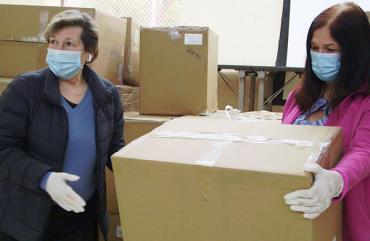A Pandemic without a Plan
I’m not a scientist or a health professional, and I don’t have a crystal ball. But I follow the news. So on Feb. 4, Sara Nelson, president of the Association of Flight Attendants-CWA, and I held a news conference to sound the alarm about the growing threat of the new coronavirus. I called on the Trump administration to act with more urgency to prevent the spread of the virus and criticized them for throwing out the Obama administration’s pandemic playbook for coordinating the U.S. government’s response to emerging disease threats.
Later that day, Trump delivered his State of the Union address. He spoke about the coronavirus for all of 20 seconds, saying that his “administration will take all necessary steps to safeguard our citizens” from the outbreak.
We now know that public health experts and intelligence agencies had been warning Trump about the threat of a pandemic as far back as November. But the president ignored—and continues to ignore—experts’ guidance. Contrary to his promise in the State of the Union, the Trump administration utterly and unforgivably failed to “take all necessary steps” to prevent massive and unnecessary loss of life, Depression-level unemployment and ruptures in our economy.
If anything, Trump’s response grew even more inept and chaotic in the days and weeks that followed. Experts call February the “lost month,” when Trump downplayed the threat of the coronavirus, claimed it would miraculously disappear, and squandered precious time to prevent its spread.
Trump’s magical thinking didn’t defeat COVID-19, and it won’t help us safely reopen our communities and our economy. He suggests there are only two choices: lock down forever, or just open up as if switching a light back on. That’s a false choice that both threatens lives and hurts the economy.
Reopening public school buildings is key to reopening the economy. America’s public schools are the heart of our communities, and many parents can’t return to work until their children are back in school. Without a vaccine, the question is how to reopen schools in a way that prevents the transmission of the virus and keeps our kids, teachers and staff safe and healthy.
Caution is paramount, as both history and current developments show. The second wave of the 1918 flu was deadlier than the first. And some children with COVID-19 have developed symptoms of Kawasaki disease. Reopening schools requires planning to prepare for—and pay for—physical distancing measures, sanitizing schools after each session, and ensuring there are adequate hand-washing stations and personal protective equipment, like masks.
Last week, the Centers for Disease Control and Prevention finally released limited guidance for reopening schools. But there are glaring omissions, such as what additional resources will be necessary to reopen schools safely and the perspectives of those who will be working in schools and sending their kids to schools. To win their confidence, key parties must be involved in reopening plans, not just be presented with them.
Last month, the AFT released “A Plan to Safely Reopen America’s Schools and Communities,” which was written in consultation with public health officials and key stakeholders. The plan is grounded in scientific evidence and public health protocols to safely, responsibly and sustainably reopen school buildings and other institutions. (The full plan is at aft.org.)
The AFT’s plan calls for communities throughout the United States to:
- Maintain physical distancing until new cases decline for at least 14 consecutive days.
- Put in place the infrastructure to test, trace and isolate new cases.
- Deploy public health tools in public schools to prevent the virus’ spread, and align them with education strategies (such as staggered scheduling) to meet students’ needs.
- Involve workers, unions, parents and communities in all planning.
- Invest federal aid to spur economic recovery, such as in the HEROES Act, which the House of Representatives just passed and the Senate must as well.
Before this crisis, 40 percent of Americans couldn’t cover a $400 emergency. In households making less than $40,000 a year, about 40 percent of those who were working in February lost their jobs in March. The images of miles-long lines at food banks and children waiting 6 feet apart to pick up grab-and-go meals at their schools are devastating. The Senate must pass the HEROES Act to protect lives, maintain essential services and restart the economy.
If what we are facing is truly comparable to the Great Depression, we should heed the lessons of that time. The New Deal wasn’t about returning to how things were before; it was about creating a new vision predicated on fairness and equality, strengthening community, and opportunity for all. We must meet this moment with that same vision and clarity, and emerge from this crisis healthier, stronger and better than before.

